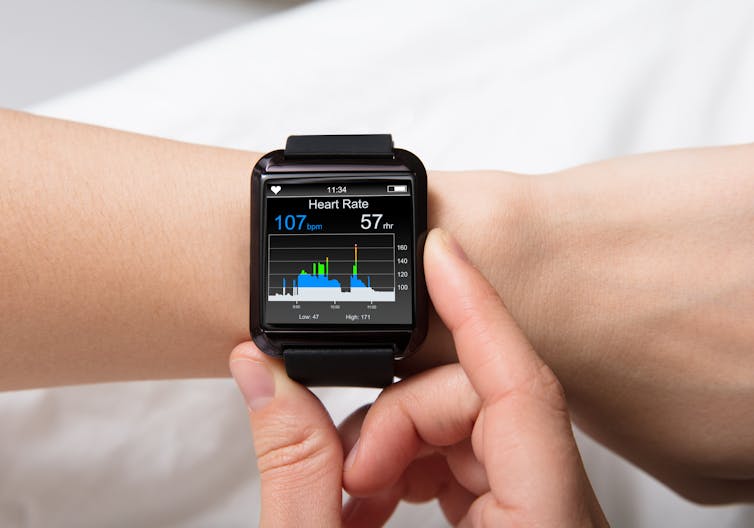The cost of poor employee well-being for individuals, organisations and society is significant – 25.7m days were lost to work-related ill health during 2016-17, half of which can be accounted for by stress, depression and anxiety. Not only is this problematic for employees and organisations, it can put added pressure on health services.
Assessing and reducing such risks is therefore important. One way this could be done is through using big data. Analysis across different data sets held within organisations could possibly improve our ability to predict and prevent such problems arising.
Organisations are required to assess risks and have a duty of care to ensure the health, safety and well-being of their employees. They may do so via an annual survey, but this is just one snapshot in time. Where problems are exposed, the events and patterns of behaviour leading up to these are in the past; the damage is already done. Fitness tracking devices, currently provided to employees by some workplaces, might offer more continuous measurement.
But such an approach focuses on limited aspects of individual well-being and not on the organisational systems and pressures that contribute to these outcomes. Concentrating on individuals without also considering organisational factors is likely to be less effective in the long term.

However, increasingly there are other data sources that might help to pinpoint well-being risks as they emerge. Employees provide huge amounts of data about their activity through their use of modern information and communication technologies. Such data includes log-in and log-off times, email traffic, use of mobile devices for work purposes, use of work-based systems and web access.
This could be linked with other data sources to find work patterns that relate to well-being. For instance, growing workload might be highlighted in part of the organisation through analysis that reveals rising work hours, fewer breaks, logging in more often at weekends (or during holidays) and more sick days. Emails could also be processed using sentiment analysis for language that reveals well-being problems. This could provide an early warning sign, allowing the problem to be fixed before employees reach breaking point.
There are a number of things that will effect whether monitoring well-being like this could work in practice. These include the quality of data available and the ability to analyse it. But most important is the organisational culture in which it is carried out as well as legal and ethical considerations. Different cultures could lead to several possible scenarios – some more utopian; others more dystopian.
Big data utopia
Using big data for monitoring well-being could have positive effects if conducted in a culture of care and trust, where employees and the organisation co-own and co-design the data collection effort, analysis and resulting actions.
Within such a scenario, there would be an exercise of joint responsibility between the organisation and employees for well-being. A code of conduct or set of action-guiding principles could be developed with employees to ensure a shared set of values to underpin fair and lawful monitoring within the organisation. Employees would be able to influence the principles, goals and best practice guidelines, and to agree what data would be gathered and how it would be used. Employees would be able to opt out of the programme without giving a reason.
If the data analysis reveals work processes that are a risk to well-being, then the organisation would take responsibility to change the way work is done or managed and would design this intervention with employees. This way the solution would fit employee and organisational needs.

Big data dystopia
But more dystopian outcomes are also possible. If data is collected within a culture of fear and distrust, then concerns about “Big Brother” and how data might be used could create an environment where employee well-being suffers dramatically.
Within this dystopian scenario, the organisational attitude would emphasise employee responsibility for well-being. Less attention would be placed on the possible work-based causes and demands. Instead, employees would be encouraged to get fitter through gym membership or cope better by attending stress management training, without the same focus on changing the work environment.
While the organisation would need to provide notification of data collection and may have received employee consent, employees might have agreed to it within the employment contract without really taking much notice at the time. If the organisation can justify that data is collected with consent or is necessary to their business, then there is little effective control offered by the law. Although there are some improvements within new data protection law these may not go far enough.
In such a culture, employees might fear that data will be used to get rid of them if they are not considered healthy enough or not coping with the work. There is legal protection against unfair discrimination, although this may not be as extensive as an individual would like, and there may be relatively little protection if the data predicts a future health condition.
The utopian and dystopian scenarios describe two extremes. Clearly there is a need to ensure organisational practice is closer to the utopian vision and further from the dystopian. But such steering is difficult to achieve. The complex interplay between organisational culture, behaviour, data science and the law means that consultation and guidance, involving experts from different subject areas, is crucial when considering the use of big data for examining employee well-being.
Originally published at The Conversation
